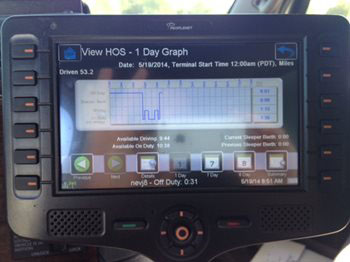 Electronic Logging Devices (ELDs) have been a hot topic lately between drivers, carriers, and the FMCSA. There are positives and negatives to each side, but the bottom line is that times are changing. Adapting to that change can be difficult, but it’s certainly possible.
Electronic Logging Devices (ELDs) have been a hot topic lately between drivers, carriers, and the FMCSA. There are positives and negatives to each side, but the bottom line is that times are changing. Adapting to that change can be difficult, but it’s certainly possible.
ELD Basics
- If the regulation is passed, ELDs will be mandatory for all drivers that are currently required to complete paper Records of Duty Status (RODS).
- Your carrier will be responsible for making sure the ELDs they provide have been registered with the FMCSA.
- Carriers will have 2-years from that date to get ELDs installed in their trucks and ready to go. They may install them sooner rather than later to account for the extra training time for drivers during transition.
Some notes about ELD and driver interaction:
- Driver should only log when the vehicle is stopped.
- Driver does not have to be prompted by the device when approaching a time limit.
- Driver will be prompted for entry if:
a. The vehicle moves with no driver (will request log-in).
b. If stopped for 5 minutes (will request duty status – the system will default to “on duty” if there is no driver entry).
c. If no position is fixed at duty change (will request location).
- System must have a mute setting to be used when the driver is in the sleeper berth.
- ELDs can be programmed to alert the driver if the vehicle stops moving after 5 minutes (to confirm driving). Other automatic duty-status settings are prohibited.
Special circumstances:
- Personal conveyance
- Not recorded as driving time (off-duty)
- Yard moves
- Recorded as on-duty not driving
- Etc.
Roadside processes:
- You must be capable of producing a graph grid at roadside, or be able to print a copy of your log.
- There should be a one-step process for data transfer (either by web, Bluetooth, or email).
The Upside of ELDs
ELDs have the potential to make a driver feel as though they are constantly being “watched”. The positive side of this is that being monitored means less stress with tracking, and less chances for error. There will be an adjustment period, and maybe some initial frustration with flexibility. However, after a little time it could end up increasing the opportunity for a more stress-free work environment.
After making the transfer to ELDs, some drivers claim to feel less stressed and less tempted to “cheat the system”. They feel that a burden has been taken off their shoulders so that they can focus on doing their jobs, rather than worrying about keeping track of everything.
A great way to help adjust to this change is to make ELDs work for you, instead of against you.
Some good advice comes from Jeff Clark – a Team Run Smart Pro with Freightliner. “Be smart and plan. If you can take your 10-hour break at a shipper, then do it. The ELogs don’t start until you start them, either with a pre-trip or by moving the vehicle. Some regular customers might even allow you to open the doors and back into a dock overnight. Do whatever you can. With ELogs you become wary of starting your day too early. You don’t want to start your clock by driving to a shipper 2 hours before your appointment and waiting. Because of the 14-hour rule I now try to be there just 30 minutes early, instead of as early as possible.”
You may have to change the way you handle your day and your schedule, but it is possible to make it work!
Important Reminders
Be sure to download your ELDs at the end of every month and save it to your computer. Create a folder on your desktop labeled “E-Logs”, then a new folder inside that for each year. Make a habit of saving each month of your E-Logs in that folder! Carriers are only required to save your logs for the past 6-months, so it’s important to maintain these records for yourself in case of an audit and to calculate your per diem days.
The ELD change is inevitably coming, but how you choose to adapt to it will truly be what affects the outcome. Go into the change with an open mind, and make the effort to think positively. It will be an adjustment, and may be difficult at times. But working on it and making the effort to be flexible will make the change a little easier.
Additional information and resources:
http://www.regulations.gov (docket number FMCSA-2010-0167), here is a direct link to the rule where you can comment:
http://www.regulations.gov/#!documentDetail;D=FMCSA-2010-0167-0972
Electronic Logging Devices (ELDs) have been a hot topic lately between drivers, carriers, and the FMCSA. There are positives and negatives to each side, but the bottom line is that times are changing. Adapting to that change can be difficult, but it’s certainly possible.